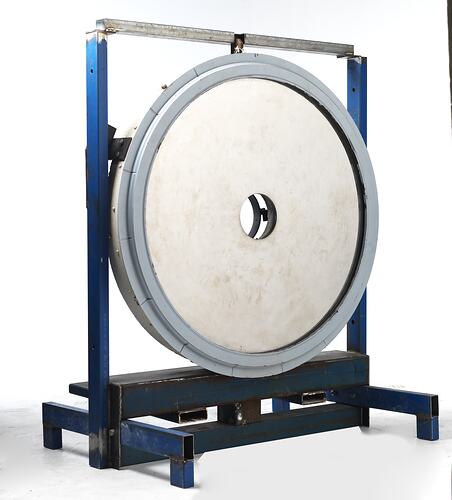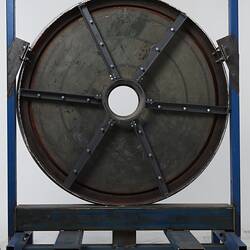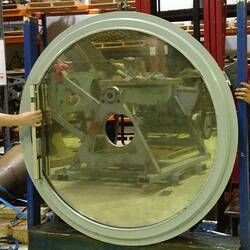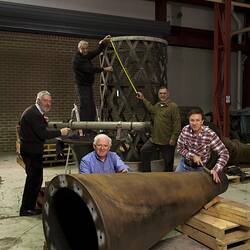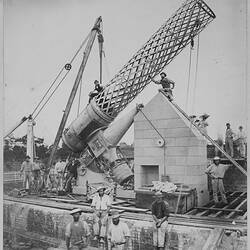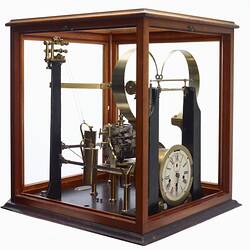Summary
Summary for Parent Object:
Great Melbourne Telescope, built by Thomas Grubb & Son of Dublin in 1866-1868 and erected at the Melbourne Observatory in 1869.
Reflector telescope, Cassegrain design, with f/41.54 focal ratio, 1994-inch (50.648 m) overall focal length
Physical Description
A 48 inch diameter (4.5 inches thickness) bronze (55% copper, 45% tin) speculum metal (mirror supported within a light green painted metal surround. Hole in centre of mirror.
Significance
This items was originally registered under ST 038755.2 as part of the GMT telescope, but as this mirror and its mounting will not be used as part of the restored telescope, and will be replaced with a replica primary mirror cell and new primary mirror cell, it was determined that for curatorial reasons this items is now better managed as a separate object with its own exhibition, conservation and location history, etc. The speculum mirror is of enormous significance in its own right as one of the few surviving original speculum mirrors from the great reflectors of the late-18th and early 19-th centuries. It was originally the Great Speculum B, or duplicate primary mirror, made for use with the Great Melbourne Telescope.
The Great Melbourne Telescope was built by Thomas Grubb of Dublin in 1868 and erected at Melbourne Observatory in 1869. It was a reflector telescope with a speculum (metal) mirror of 48 inches diameter; at the time it was the second largest telescope in the world and the largest in the southern hemisphere.
The design and construction was overseen by a committee of eminent British astronomers, who developed the telescope to study the nebulae of the southern hemisphere skies. It was the first major telescope built by Thomas Grubb, and revolutionary in many aspects of its design. The firm went on to make many of the major telescopes around the world in the second half of the nineteenth century.
The telescope never lived up to expectations, due to difficulties with constant tarnishing of its mirrors, flexure in the mirrors, and its relative unsuitability for the new astronomical techniques of photography and spectroscopy.
The telescope was operated at Melbourne Observatory by a dedicated Great Melbourne Telescope Observer: Albert Le Seuer (1869-70), E F MacGeorge (1870-72), Joseph Turner (1873-83), Pietro Baracchi (1883-92); thereafter it was used only intermittently.
When Melbourne Observatory closed in 1944, the telescope was sold to the Commonwealth Observatory at Mount Stromlo, Canberra.
More Information
-
Collection Names
Great Melbourne Telescope Restoration Project, Melbourne Observatory Collection
-
Collecting Areas
-
Acquisition Information
Donation from Australian National University (ANU), 1984
-
Maker
-
South Yarra, Greater Melbourne, Victoria, Australia, 1869-1945
-
South Yarra, Greater Melbourne, Victoria, Australia, 1883-1892
Observer at the Melbourne Observatory -
Mount Stromlo, Greater Canberra, Australian Capital Territory, Australia, 1945-2003
-
Classification
-
Category
-
Discipline
-
Type of item
-
Overall Dimensions
250 (Depth), 1400 (Outside Diameter), 1245.5 kg (Weight)
Mirror Stillage: 2400mm width x 2070mm height x 1170mm depth Above dimensions are for Mirror Only. Weight is for the mirror and surround.
-
References
Gillespie, Richard & Museum Victoria 2011, The great Melbourne telescope, Museum Victoria, Melbourne; Robinson, Thomas Romney & Grubb, Thomas & Royal Society (Great Britain) 1869, Description of the great Melbourne telescope, Royal Society of London, [London]; Monash University Museum of Art. 2013. Simon Starling: In Speculum. [ONLINE] Available at: [Link 1] [Accessed 7 December 2017]; Radio National, Australian Broadcasting Corporation. (2013). Books & Arts. Simon Starling: In Speculum. [ONLINE]. 18 July 2013. Available from: [Link 2] [Accessed: 7 December 2017]
-
Keywords
Astronomical Instruments, Observatories, Reflector Telescopes, Telescopes, Telescope Components
